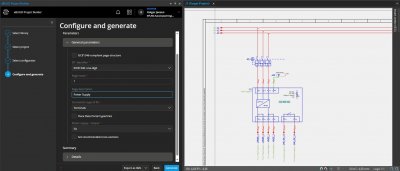Automatic Schematic Generation in the Cloud
Automating the generation of schematics leads to faster results and fewer errors. Solutions provider Eplan has developed a variety of technical approaches for this process.

Holger Jansen ““The new context-sensitive Inline app assistance technology gets users faster results,” says Eplan’s Business Owner Functional Design Holger Jansen.
One of these is the cloud-based software eBuild, with which users can generate their projects with a simple mouse click. The new Version 2025 is now available – with significant advantages in ease of use, operation, and for configurating and generating schematics.
Automatically generating schematics is nothing new. Exactly how this happens is getting increasingly innovative and one thing is clear: the cloud has become indispensable in this process. Eplan’s eBuild software, which is fully integrated into the Eplan Cloud, now offers even more ease of use and maximum simplicity. The new Version 2025, which is available now, impresses with numerous improvements for the more efficient use of macro technology in engineering. “We have developed a solution that is easy to use, but at the same time is very innovative in terms of its functionality,” says Eplan’s Business Owner Functional Design Holger Jansen.
Operation in the cloud – even easier and now context sensitive
The user interface has been optimised so that users simply have a better overview of the project even more quickly. For instance, the new Navigator bar means that users can keep an eye on the eBuild configuration and generation process at all times. And that is not all on the technology side of things. “The new context-sensitive Inline app assistance technology gets users faster results,” Jansen says. “This new help functionality, which is directly embedded inline into eBuild, makes it even easier to use.”
How it works
The process is very easy. Users just log into the Eplan Cloud and can access their own projects via their company organisation in the cloud. No software installation is necessary for this. In Project Builder – a part of Eplan eBuild – the corresponding macro libraries can be selected and then the project can be configurated and/or generated. The new Navigator supports users in this area by making the selection process easier. End-to-end data consistency – from product structuring to the actual project realisation – is also ensured on the system side by complying with guidelines and standards.
Configuration in the cloud means easier and faster results
A set of rules and configuration interfaces can be intuitively and quickly created without knowing any higher programming languages – skills in Eplan macro technology suffice here. These Eplan macros are then augmented in eBuild with a set of rules. Users next use this configuration method to input their client’s requirements for a machine or plant system. A new feature in eBuild 2025 is the ability to configure from an internet browser – on Windows, Android or iOS. So there are no longer any obstacles for using eBuild as an engineering configurator on mobile devices.

Eplan eBuild 2025 The new Wizard reliably guides users through the configuration process to automatically generate the schematics.
Generation in the cloud means even more collaboration
Along with configuration, generating projects is fully cloud based in eBuild 2025, meaning a local installation of the Eplan software is no longer necessary. Schematics can be directly generated in the cloud via an Eplan Project provided by eManage. Using eView, Eplan’s proprietary viewer in the cloud, projects and documentation can be displayed on any device – whether it be on a tablet, a smartphone or a browser and it of course works in both iOS and Android environments. The plans can be checked here and changes can be fed back into the project using the redlining and greenlining functionality in the viewer.
In conclusion
Using Eplan eBuild in the cloud, schematics can now be created from an internet browser. The advantages are clear: schematics can not only be created in the construction design process, but they can also be made available with a mouse click much earlier during the tendering process or in the preplanning project phase.
Find out more at: www.eplan.com


